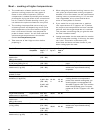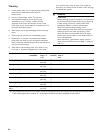
46
Poultry
▯ The humidity during combined operation prevents
drying out which, especially in the case of poultry,
is crucial. At the same time, the high temperature
lends crispy browning to the surface. The heat
transmitted by the hot steam is twice as high as in
the case of conventional hot air and it reaches all
parts of the food. This is why a chicken becomes
browned and crispy all-round, and nevertheless
the breast meat stays tender and juicy.
▯ The cooking times specified serve to help you
orientate yourself and depend very much on the
initial temperature of the food. Use the core
temperature probe for better control. Do not
place it in the middle (cavity), but between the
belly and the thigh. You will find further notes and
optimum target temperatures in the section
entitled Core temperature probe.
▯ If you season poultry mainly with spices and with
little or no oil, the skin will become crispier.
Foodstuff Cooking
receptacle
Tempera-
ture in °F
(°C)
Humid-
ity in %
Cooking
time in
min.
Remarks
Duck, whole (3 kg/6.6 lb) Unperforated 1) 300 - 320
(150 - 160)
2) 430 (220)
60
0
80 - 90
20 - 30
Start cooking with the breast pointing
down. Turn the duck round after half of
the cooking time. In this way, the sensi-
tive breast meat will not dry out so much.
Duck breast, browned,
medium-rare
(350 g/12 oz each)
Unperforated 320 - 355
(160 - 180)
0 8 - 15
Chicken, whole
(1.5 kg/3.3 lb)
Rack 1) 340 - 355
(170 - 180)
2) 365 (185)
60
0
30 - 45
15 - 20
Chicken breast, stuffed,
steamed (200 g/7 oz each)
Perforated 212 (100) 100 10 - 15
Turkey breast fillet, steamed
(300 g/11 oz) each
Perforated 212 (100) 100 12 - 15
Spring chicken, quail,
pigeon (300 g/11 oz each)
Perforated 212 (100) 100 25 - 30
Spring chicken, quail,
pigeon (300 g/11 oz each)
Perforated 355 - 390
(180 - 200)
60/80 12 - 16


















